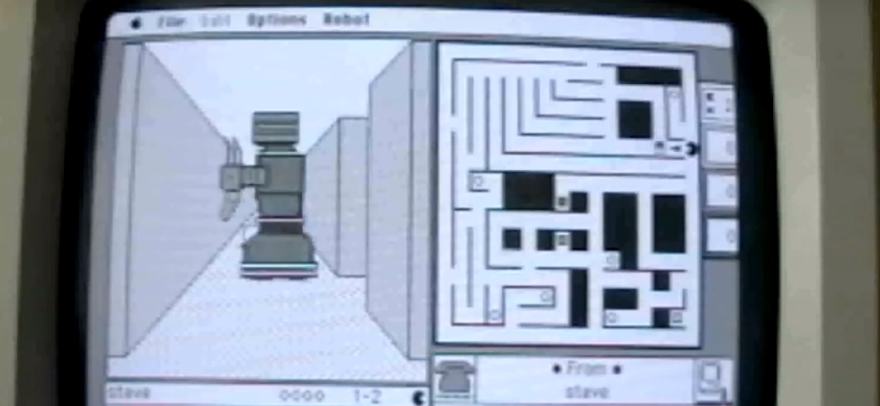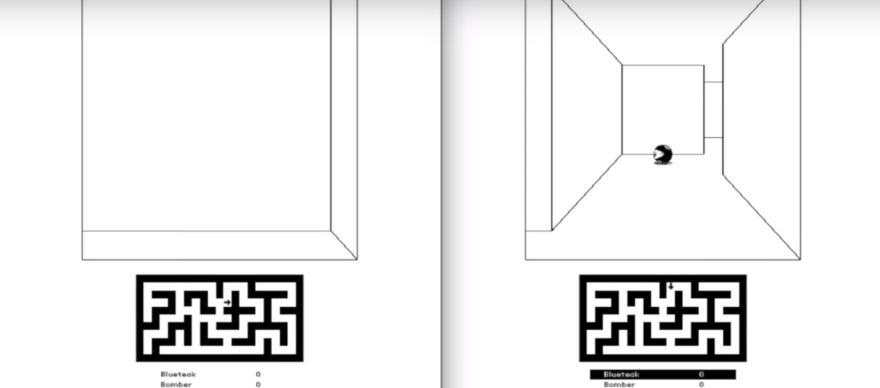
It is sometimes hard to know how far back to go when chronicling the history of early MMOs and their ancestors. After all, this column has looked at several titles (such as Habitat and Neverwinter Nights) that do not fit the modern definition of an MMORPG yet were bound in blood to the genre nonetheless.
So if today’s game seems to be somewhat tenuously related to our favorite hobby, I beg your forgiveness in advance. However, I do feel that it is pertinent to our exploration of this wonderful genre. The game in question is Maze War, and it holds an admiral uniform’s worth of medals depicting firsts in the infant genre of video games. Most importantly for us, Maze War was the first graphical video game to be networked and allow players to interact and fight each other. You can see why that may tie in to our current situation.
While the game itself certainly never attained the complexity of modern shooters or RPGs, its innovation and pioneering certainly make it worthy of examination. So let’s dust it off and get to it!
https://www.youtube.com/watch?v=G-GY3bO0YsI
Mazes and machines
Today we’re going to set the Game Archaeologist time machine back to 1973 — three years before your humble author was even born. A summer intern named Steve Colley was working at NASA Ames in California and fiddling around with the institution’s Imlac PDS-1 and PDS-4 machines, the same computers that were being used to work on the space shuttle project.
While doing this, Colley whipped up a program in which the user wasn’t just looking at a maze from above — but was in the maze itself. Maze was fairly straight-forward: Players were tasked with navigating to the end of a maze, at which point the game would be over.
The idea of creating a 3-D game in 1973 was almost laughable when you consider that the world’s most popular video game, Pong, was merely a couple of lines and a dot. Yet Colley and his friends realized that mazes contained 90-degree angles that would be relatively easy to render, and so it did.
As a side project it was an interesting concept, especially for its first-person perspective, but as a game, it was terminally boring. Fortunately, a couple of Colley’s co-interns, Greg Thompson and Howard Palmer, looked at Maze and saw more potential in it.
From Maze to Maze War
“Someone had the idea to put people in the maze,” Colley later wrote. “To do this would take more than one Imlac, which at that time were not networked together. So we connected two Imlacs using the serial ports to transmit locations back and forth. This worked great, and soon the idea for shooting each other came along, and the first person shooter was born.”
Decades before Doom popularized the first-person shootouts over networks, Maze War was doing the same in the mid-’70s. At this point of its development, it is best to think of Maze War as a football, passed from party to party without concern over copyrights or ownership. What Colley and his friends started at NASA soon became a video game juggernaut in its own right.
In 1974, Thompson took the program with him back to MIT, where he upgraded it to run over the Arpanet (a precurser to the modern internet). Before then, Maze War could only pit two players against each other with locally connected machines. The speeds used to transmit this information between computers was painfully slow — merely 50 kbit/sec — and yet it worked. Three years before Star Wars: A New Hope hit theaters, it was already online.
Playing Maze War
Maze War was first-person shooter simplicity to the core. Players took on the role of a flying eyeball and navigated a maze, moving either forward, backward, or turning 90 degrees to the left or right. While players could see their own position on the maze map, other players were hidden from sight. The goal was easy: Find and shoot the enemy before he did the same to you. If you killed an enemy, you’d get 10 points, while he lost five.
Players quickly learned a few key strategies, such as hiding in ambush and shooting opponents in the back. You could also “peek” around a corner without exposing yourself, which was essential to staying out of the enemy’s sights.
The game that ground the online world to a halt
Maze War became so insanely popular that it started to cause problems. “Legend has it that at one point during that period, Maze War was banned by DARPA from the Arpanet because half of all the packets in a given month were Maze War packets flying between Stanford and MIT,” Thompson recalled.
“I was at Xerox P.A.R.C. when Maze Wars was first released on the Alto,” said David Maynard. “I believe this was in 1976 or 1977. It was an immediate hit with all the engineers. For a little while, work almost stopped. Management was powerless to do anything about it. You could hear the distinctive clicking of the keysets as you walked down the hallways.”
By 1977, Thompson and his friends had built a computer dedicated to running Maze War and had added the ability to go up and down levels. Dave Lebling created a server that allowed for eight-person battles.
From there, programmers at other institutions, such as Xerox, got a hold of the code and upgraded it for different computers and connections. Yet it wasn’t until 1986 that Maze War was fully upgraded into an online networked game. Another programmer named Christopher Kent was able to use the internet’s TCP/IP protocol to allow players to battle others in Maze War on the internet, a first for the genre.
An enduring legacy
Maze War’s legacy is hard to overstate. It helped create the first-person shooter, online gaming, and internet gaming. Innovations we take for granted, such as a radar, level editing, observer mode, and avatars all saw their beginnings (or one of the very first appearances) in this title.
On top of all that, soon after its creation, many computer RPGs stole Maze War’s first-person perspective for dungeon crawls (such as Wizardry). RPGs, MMOs, and FPSes all owe a debt of gratitude to this off-the-cuff project created by a handful of interns back when driftwood furniture and earth tones were all the rage.
Today, Maze War mostly endures as an internet curiosity (but not a very well remembered one). You can play even play it right now and get a taste of history that you might have missed the first time around.
 Believe it or not, MMOs did exist prior to World of Warcraft! Every two weeks, The Game Archaeologist looks back at classic online games and their history to learn a thing or two about where the industry came from… and where it might be heading.
Believe it or not, MMOs did exist prior to World of Warcraft! Every two weeks, The Game Archaeologist looks back at classic online games and their history to learn a thing or two about where the industry came from… and where it might be heading.















